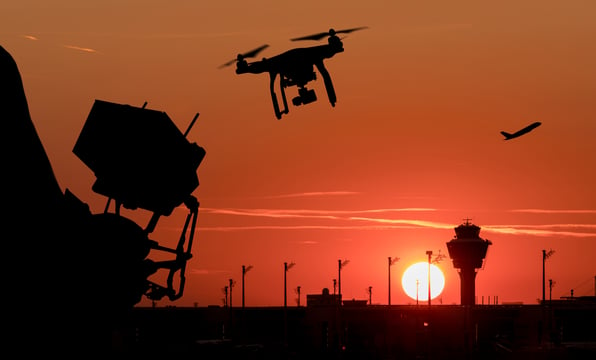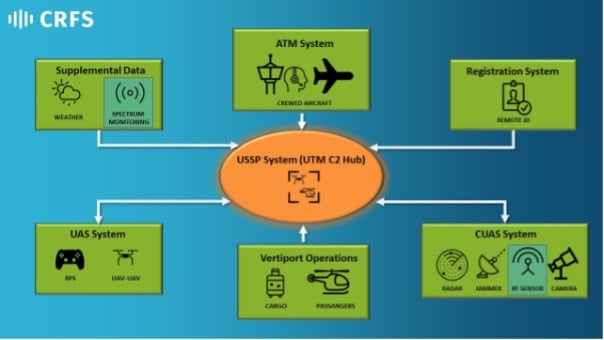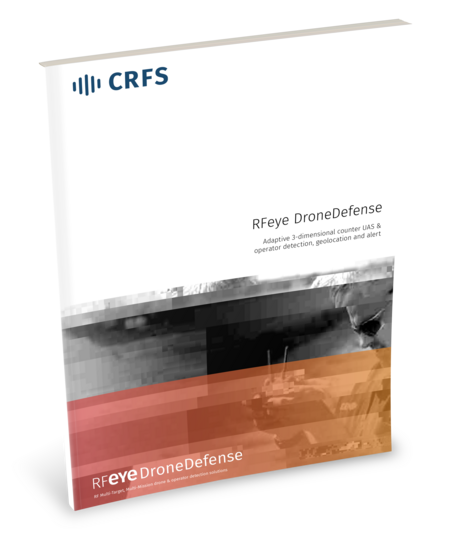
Advanced Air Mobility (AAM) envisions a future where aerial transportation is not limited to traditional aircraft—it expands to include drones, air taxis, and other autonomous flying vehicles. However, new challenges come with this expansion, particularly in ensuring the safety and security of the Unmanned Traffic Management (UTM) airspace, both in Beyond Visual Line of Sight (BVLOS) and Visual Line of Sight (VLOS) operations. At this level, Counter-Unmanned Aircraft Systems (C-UAS) technology becomes crucial.
This blog explores the threats to Advanced Air Mobility and why C-UAS, empowered by Radio Frequency sensors, is essential for successfully implementing AAM.
What are the threats to advanced air mobility?
As the airspace becomes more crowded and accessible, unauthorized or malicious unmanned aircraft systems (UAS) pose significant risks to AAM infrastructure and public safety.
The open nature of AAM operations, including urban air mobility, package delivery, and air taxis, presents vulnerabilities that malicious actors can exploit. These risks include unauthorized UAS flights, potential airspace intrusions, and the potential for UAS to interfere with critical infrastructure or communication networks.
Unauthorized UAS can disrupt AAM operations, compromise the safety of passengers and other aircraft, and jeopardize public safety. Threats may range from surveillance, smuggling, or unauthorized access to sensitive areas, to deliberate acts of terrorism or sabotage. The compact size, agility, and potential payload capacity of UAS make them an attractive tool for those with malicious intent.
The AAM industry can ensure safe and secure operations by recognizing potential threats and implementing robust security measures. Implementing RF-enabled C-UAS systems as part of the overall security framework helps protect critical AAM infrastructure, maintain public trust, and foster the continued growth and advancement of the AAM ecosystem.
What is a Counter Unmanned Aerial System?
C-UAS employs various technologies and techniques to detect, identify, track, and mitigate the threat posed by unmanned aerial vehicles (UAVs), commonly known as drones. C-UAS systems are designed to protect against unauthorized or malicious drone activities that could pose security risks or disrupt operations.
C-UAS techniques are carried out by command and control centers, which coordinate the overall response using data from various sensors.
Drone detection – Different types of sensors, including radio frequency (RF) sensors, acoustic sensors, electro-optical/infrared, Radar, and combined sensors, are used to detect the presence of UAVs within a specified area or user-created geofence.
Drone identification – once detected, C-UAS systems classify the drone and determine relevant information.
Countermeasures – If deemed a threat, the drone is neutralized using techniques such as radio frequency (RF) jamming, GNSS jamming, and GPS spoofing.
What is an RF-enabled C-UAS?
While most C-UASs use Radar and cameras, the best-in-class systems always include RF sensor technology—an excellent addition as they are passive (as no electromagnetic energy is emitted, unlike Radar). Therefore, the technology can be placed in locations where Radar cannot. Moreover, it can “tip and cue” Radar and optical sensors during the find, fix, and target phases of a detect-to-engage sequence, and it can verify if a drone was downed by monitoring for a lost drone signal (known as loss link).
Video: Drone detection field trial
What are the benefits of RF-enabled C-UAS?
Safeguarding airspace integrity
As AAM evolves, the skies will become increasingly crowded with various aircraft types. Ensuring airspace integrity becomes paramount to prevent collisions, maintain efficient UTM, and protect the lives of passengers and people on the ground.
C-UAS systems act as a vital layer of defense, capable of detecting and neutralizing unauthorized or rogue drones that pose a threat to flight operations safety. By deploying RF-enabled C-UAS technology, operators can passively monitor and safeguard the airspace by using geofence alarms and automated actions, enabling safe and reliable transportation for both passengers and cargo.
Mitigating security risks
In an era where terrorism and unauthorized activities are ever-present concerns, the security of AAM infrastructure (such as vertiports) is of the utmost importance. The open nature of AAM systems, with their vast network of ground infrastructure and airspace integration, presents potential vulnerabilities.
C-UAS systems play a vital role in mitigating security risks by detecting and responding to unauthorized drones that may be carrying explosive devices, conducting surveillance, or disrupting the normal operations of AAM vehicles and UTM airspace.
Protecting privacy
As AAM technology advances, concerns surrounding privacy and data protection emerge. RF-enabled C-UAS systems can help address these concerns by preventing intrusive or unauthorized drones from encroaching on private property or violating individuals' privacy rights. By implementing effective C-UAS solutions, stakeholders can ensure that Advanced Air Mobility operates in a manner that respects citizens' privacy and adheres to legal and ethical standards.
Managing air traffic
Efficient management of air traffic is critical for the success of AAM. The same RF sensors employed for C-UAS can also feed a larger UTM Command and Control system. The RF sensors can play a significant role in monitoring and managing the flow of aerial vehicles, ensuring smooth integration and coordination among different operators.
By using real-time data and conducting signal geolocation, RF sensors can assist in optimizing routes, preventing congestion, and maintaining operational efficiency. This enhances the overall safety of AAM operations and helps maximize UTM airspace capacity and minimize delays.

RF Sensors are critical not only as a CUAS sub-system but also as a supplemental data provider for spectrum monitoring to the UTM system.
The importance of adapting to future challenges
As technology continues to evolve, so do the threats and challenges AAM systems face. C-UAS solutions must be adaptable and capable of evolving alongside emerging threats. By staying ahead of the curve and continuously improving their capabilities, C-UAS systems can effectively counter new risks, such as swarm drones or advanced hacking techniques.
Conclusion
Advanced Air Mobility holds tremendous potential for transforming how we travel and transport goods. However, with this innovation comes the responsibility to establish robust safety and security measures. RF-enabled C-UAS is indispensable in ensuring airspace integrity, mitigating security risks, protecting privacy, managing air traffic, and adapting to evolving challenges.
By investing in and deploying effective RF-enabled C-UAS systems, stakeholders in the AAM industry can build a safe, secure, and sustainable future for aerial transportation. As technology advances, ongoing collaboration between industry stakeholders, regulatory bodies, and technology providers will also grow.
Zac George
Zac George is the International Business Development Manager for CRFS. He is a former naval Electronic Warfare officer and also has experience in digital decoding. He speaks regularly on EW and spectrum topics globally, and lives in Switzerland.



